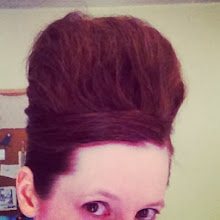In 1992 when I was a second-year undergraduate I'd gotten out of the shoebox I'd endured as a fresher and had a human-sized room in a building called Jeopardy. Actually it was called the War Memorial Building but the warden had made a crack decades before about lazy-ass students finding their places in jeopardy and if there's anything we know about the fifties it's apparently that no Anglophone undergraduate ever resisted a chance at terrible wordplay. It had big sliding windows and a tree outside where a pair of crimson rosellas lived. I kept salami and seaweed crackers in a cupboard and broke Tetris for Windows 3.0 several times.
There's a library there now.
A friend of mine had just discovered that her long vision was screwy and she had new spectacles. We ate toast from the contraband toaster in her room while she tried to absorb the appalling sharpness of the world. She pointed out the window. Do you see those leaves? Yes, I said. I didn't, she said. It used to be this beautiful green and yellow and white blur that moved in the wind. It's so ... realistic now.
She hadn't realised that her vision needed correcting until she learned to drive.
There must have been a time when TinyXtin came to understand that some of the book-places and telly-places and cinema-places were real places where real people lived. I don't remember that. I wish I did -- how does that work? I don't remember a time I didn't understand that the fictional world contained fictional things -- that is why things are different there, and full of things I'd never seen like wizards and trees with tiny apothecaries inside and intergalactic warfare and fairies and armoured bears, but also snow and badgers and grizzly bears and cactuses and enormous houses in the countryside with walled gardens. But by magic it turns out that some of these things aren't invention. They are just very far away, where things are different.
It must have crept up on me, this dim understanding that some unseen things were not make-believe. An odd phrase, no? Make-believe? Beliefs made and unmade and made back part of the way. Sometimes whatever clues TinyXtin used were not there and the real never emerged from the story. Susan Cooper's The Dark is Rising was one of the books of my small life that forms the pillars at the end of the world. I read it when I was 12, in early 1985. Loop-the-looped with Arthurian romance, iron sun-crosses in little boy's pockets, absolutely black horses, absolutely white horses, lodestone pebbles, Wren Day. Herne. Merlin. It is set in the Thames Valley. It is as riveting and soul-tearing an evocation of a winter English landscape as has ever been committed to the page.
I thought it was all pretend.
TinyXtin sang in a choir. At the end of the year there was the Big School carol service at St Paul's Cathedral on the corner of Swanston Street in Melbourne, just across from the iconic clocks at Flinders Street Station. The clocks were part of that disappearing family of collisions between place and object that helped things get organised before mobile phones. I'll meet you under the clocks. TinyXtin Choir sang one carol during the service, because we were the adorable tinies, and then Big School choir sang the rest in ten-part Latin and did that thing that King's does every year with Once In Royal David's City and blew my mind in that way that complexity which turns to simplicity can amaze small people.
One year we tinies learned an Australian carol for the cathedral: Christmas Day (The North Wind), by the Australian pianist William G James. James was from Ballarat in the heart of the Victorian goldfields 100 kilometres north-west of Melbourne, home of the Eureka Stockade and crucible of Australian democracy. He trained in London and Brussels and became the first Director of Music at the ABC. The lyrics were by John Wheeler, who was an ABC staff writer at the time:
The north wind is tossing the leaves.
The red dust is over the town;
The sparrows are under the eaves,
And the grass in the paddock is brown;
As we lift up our voices and sing,
To the Christ-child the heavenly King.
The Australian north wind is not the one in books. Not like the pictures of a frozen, pinched-faced Zeus-type with icicles for eyebrows, Aesop's north wind gusting at the man wrapping his coat around himself tighter and tighter and losing to the sun. The Australian north wind is hot. Straight off the desert, dry and bone-parching. A northerly again tomorrow, wilted Australians say to one another tiredly.
I knew it was a peculiar beast, this strange black-sheep carol which described a hot Christmas like all the ones I'd ever celebrated. Red dust caking all the school windows after the dust storm in 1983 when 1000 tonnes of Mallee soil were dumped on Melbourne. It had the sparrows in it, even, the very ones in my very life, hot-weather-sleeked brown-and-brown like collections of winged toast crumbs in small flocks anywhere shady, listening to the rhythmic treble white noise of cicadas screaming.
It was a joyous, leaping carol and I delighted in its warmth and rhythms. But I hoped I'd never have to sing it again. It was mutant, somehow, part of the mythological menagerie of chimerical animals, and it made me feel strange.



No comments:
Post a Comment